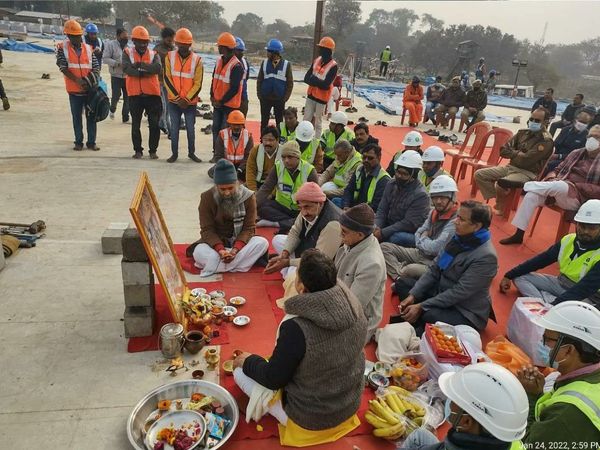The laying of the granite stones for the plinth of the Ram temple at Ram Janmabhoomi in Ayodhya marked the beginning of the third phase of the building of the Ram temple on January 24.
The construction of a granite stone plinth has begun in order to achieve strength, as well as other physical and chemical characteristics, and hence long-term durability.
It was determined to employ the most durable natural granite from southern India, keeping in mind the temple's thousand-year and beyond history as inspiration.
It is estimated that around 17,000 stones with dimensions of 5 feet 2.5 feet 3 feet would be utilized in the building of the Temple's plinth. It is estimated that each stone weighs around 2.50 tonnes. The laying of granite stone is expected to be completed by May 2022, according to current estimates.
When it comes to monitoring the safety characteristics of the temple, digital instrumentation is being employed. The data collected by this equipment will be utilized to investigate the behavior of the structure under various loading conditions, such as earthquakes.
The final version of the master plan for the full campus outside of Parkota has been completed and authorized by the appropriate statutory authorities.
It consists of a number of buildings, including a Pilgrimage Facilitation Center, a Museum, an Archives, a Research Center, an Auditorium, a Gaushala, a Yagya Shala, and an Administrative Building. Details of the design and utility services are being worked out, and construction work on structures other than the temple will begin in April 2022, with completion expected in April 2022.
The carved Bansi Paharpur stone from Rajasthan will be used in the construction of the temple's superstructure. The carving, which is being overseen by architect M/s CB Sompura, has been carried out specifically by trained individuals in particular.
By December 2023, worshippers will have the opportunity to see Lord Shri Ram in person because the temple building is developing according to schedule.
According to the Supreme Court's decision on November 9, 2019, the Shri Ram Janmabhoomi Teerth Kshetra Trust was given the responsibility of overseeing the construction of the Shri Ram Temple in Ayodhya, which began in February 2020.
The construction committee chaired by Shri Nripendra Misra was established by the Trust for the benefit of the public.
The building of the temple has been assigned to M/s Larsen and Toubro, with project monitoring being carried out by M/s Tata Consulting Engineers in close collaboration.
The construction of a three-story temple with a Garbh Griha and five Mandapas is underway.
The temple building area is roughly 10 acres, with the creation of a complex of 57 acres, which will provide a variety of amenities for pilgrims to enjoy. It is proposed to establish a museum and research center in Ayodhya to preserve the historical, monumental, and architectural value of the city. Rajasthani and Karnatakai stones will be used in the construction of the temple complex.
Following the completion of the appropriate soil tests, it was determined that the entire area would be dug up and excavation work up to a depth of 12 meters would be carried out. The dirt has been replaced by a solid designed rock that has been laid down in 48 layers and compacted with a mechanical roller. The entire volume of excavation was 70 lakh cubic feet (cubic feet). Approximately 44.5 lakh cubic feet of concrete were laid and the strength and other civil criteria were meticulously evaluated during the construction process.
After the excavated space, which serves as the foundation, has been filled, a five-foot-thick cement concrete raft has been built on top.
On the basis of thermal and other engineering indicators, a team of specialists from several IITs, including the Central Building Research Institute in Roorkee, attentively watched the behavior of the concrete in the test chamber. This project was finished before the commencement of the monsoon season.
The drawings and design have been overseen by representatives from the Indian Institutes of Technology (IITs) Chennai, Kanpur, Surat, CBRI Roorkee, M/s Tata Consulting Engineers, and the implementing company, Larsen & Toubro.







